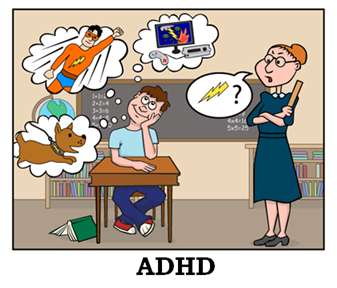ADHD

The two conditions are related. ADD stands for attention deficit disorder. ADHD stands for attention deficit hyperactivity disorder — a condition with symptoms such as inattentiveness, impulsivity, and hyperactivity. The symptoms differ from person to person.
Both children and adults can have ADD/ADHD, but the symptoms always begin in childhood. Adults with ADD/ADHD may have trouble managing time, being organized, setting goals, and holding down a job.
Overview
Attention-deficit/hyperactivity disorder (ADHD) is a disorder marked by an ongoing pattern of inattention and/or hyperactivity-impulsivity that interferes with functioning or development.
- Inattention means a person wanders off task, lacks persistence, has difficulty sustaining focus, and is disorganized; and these problems are not due to defiance or lack of comprehension.
- Hyperactivity means a person seems to move about constantly, including in situations in which it is not appropriate; or excessively fidgets, taps, or talks. In adults, it may be extreme restlessness or wearing others out with constant activity.
- Impulsivity means a person makes hasty actions that occur in the moment without first thinking about them and that may have a high potential for harm, or a desire for immediate rewards or inability to delay gratification. An impulsive person may be socially intrusive and excessively interrupt others or make important decisions without considering the long-term consequences.
Signs and Symptoms
Inattention and hyperactivity/impulsivity are the key behaviors of ADHD. Some people with ADHD only have problems with one of the behaviors, while others have both inattention and hyperactivity-impulsivity. Most children have the combined type of ADHD.
In preschool, the most common ADHD symptom is hyperactivity.
It is normal to have some inattention, unfocused motor activity, and impulsivity, but for people with ADHD, these behaviors:
- are more severe
- occur more often
- interfere with or reduce the quality of how they function socially, at school, or in a job
Inattention
People with symptoms of inattention may often:
- overlook or miss details, make careless mistakes in schoolwork, at work, or during other activities
- have problems sustaining attention in tasks or play, including conversations, lectures, or lengthy reading
- not seem to listen when spoken to directly
- not follow through on instructions and fail to finish schoolwork, chores, or duties in the workplace or start tasks but quickly lose focus and get easily sidetracked
- have problems organizing tasks and activities, such as what to do in sequence, keeping materials and belongings in order, having messy work and poor time management, and failing to meet deadlines
- avoid or dislike tasks that require sustained mental effort, such as schoolwork or homework, or for teens and older adults, preparing reports, completing forms, or reviewing lengthy papers
- lose things necessary for tasks or activities, such as school supplies, pencils, books, tools, wallets, keys, paperwork, eyeglasses, and cell phones
- be easily distracted by unrelated thoughts or stimuli
- be forgetful in daily activities, such as chores, errands, returning calls, and keeping appointments
Hyperactivity-Impulsivity
People with symptoms of hyperactivity-impulsivity may often:
- fidget and squirm in their seats
- leave their seats in situations when staying seated is expected, such as in the classroom or the office
- run or dash around or climb in situations where it is inappropriate or, in teens and adults, often feel restless
- be unable to play or engage in hobbies quietly
- be constantly in motion or “on the go,” or act as if “driven by a motor”
- talk nonstop
- blurt out an answer before a question has been completed, finish other people’s sentences, or speak without waiting for a turn in a conversation
- have trouble waiting for his or her turn
- interrupt or intrude on others, for example in conversations, games, or activities
ADHD symptoms can appear as early as between the ages of 3 and 6 and can continue through adolescence and adulthood. Symptoms of ADHD can be mistaken for emotional or disciplinary problems or missed entirely in quiet, well-behaved children, leading to a delay in diagnosis. Adults with undiagnosed ADHD may have a history of poor academic performance, problems at work, or difficult or failed relationships.
ADHD symptoms can change over time as a person ages. In young children with ADHD, hyperactivity-impulsivity is the most predominant symptom. As a child reaches elementary school, the symptom of inattention may become more prominent and cause the child to struggle academically. In adolescence, hyperactivity seems to lessen and may show more often as feelings of restlessness or fidgeting, but inattention and impulsivity may remain. Many adolescents with ADHD also struggle with relationships and antisocial behaviors. Inattention, restlessness, and impulsivity tend to persist into adulthood.
Work Cited: National Institute of Mental Health-Attention-Deficit/Hyperactivity Disorder
https://www.nimh.nih.gov/health/topics/attention-deficit-hyperactivity-disorder-adhd
If your child shows symptoms of ADD/ADHD, Training Gifted Minds offers the Davis® Attention Mastery program.
Professional services described as Davis®, including Davis Dyslexia Correction®, Davis Symbol Mastery®, Davis Orientation Counseling®, Davis® Attention Mastery, Davis® Math Mastery, and Davis® Reading Program for Young Learners may only be provided by persons who are trained and licensed as Davis Facilitators or Specialists by Davis Dyslexia Association International.

